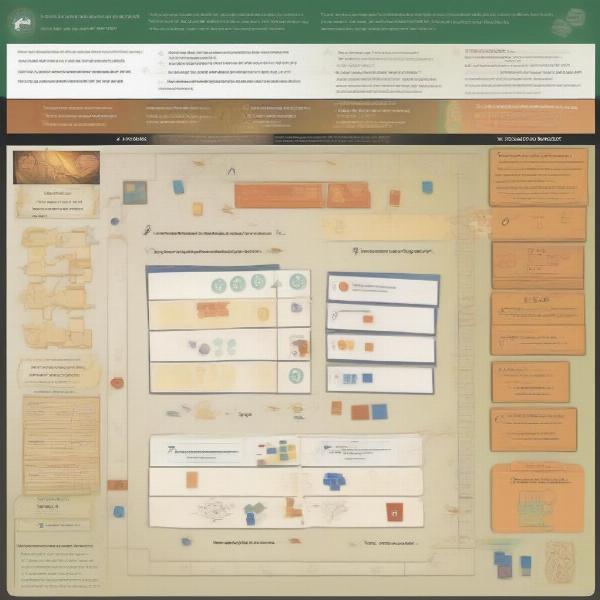Creating a mathematical board game is a fun and engaging way to combine learning with play. Whether you’re a teacher looking for a classroom activity, a parent wanting to supplement your child’s education, or simply a game enthusiast with a passion for numbers, this guide will walk you through the process of designing your own math-based board game.
Designing the Core Game Mechanics
The first step in How To Make A Mathematical Board Game is determining the core mechanics. What mathematical concepts will your game focus on? Will it be about addition, subtraction, multiplication, division, fractions, geometry, or perhaps a combination of several concepts? Choosing a specific focus will help you tailor the game mechanics and ensure a cohesive learning experience. For younger children, simple addition and subtraction might be ideal. For older players, you could explore more complex concepts like algebra or probability.
Creating the Game Board
The game board is the visual centerpiece of your creation. It can be as simple as a numbered track or as intricate as a map with different territories. The design should reflect the mathematical theme and provide a clear path for players to progress. Consider using colors, shapes, and symbols that reinforce the mathematical concepts being explored. A visually appealing board can significantly enhance the overall playing experience.
Developing the Rules and Instructions
Clear and concise rules are essential for any board game. When writing the rules for your mathematical game, ensure they are easy to understand and follow, even for players unfamiliar with the specific mathematical concepts. Start by outlining the objective of the game. How do players win? Then, detail the steps involved in each turn, including how players move, how mathematical problems are generated, and how scores are calculated.
 Example of Math Board Game Rules
Example of Math Board Game Rules
Incorporating Mathematical Challenges
The heart of your mathematical board game lies in the challenges players face. These challenges should be integrated seamlessly into the gameplay and aligned with the chosen mathematical concepts. For example, players might roll dice and then need to add, subtract, multiply, or divide the resulting numbers. Alternatively, they could draw cards with math problems to solve in order to advance on the board.
Balancing Fun and Education
While the primary focus is on mathematics, remember that the game should also be fun! Nobody wants to play a game that feels like a tedious math lesson. Introduce elements of chance, strategy, and player interaction to keep the game engaging. You can incorporate special spaces on the board that trigger bonus challenges or setbacks, or include cards that allow players to interact with each other, adding an element of unpredictability and excitement.
 Balancing Fun and Learning in a Math Game
Balancing Fun and Learning in a Math Game
Playtesting and Refinement
Before finalizing your game, thorough playtesting is crucial. Gather a group of target players and observe how they interact with the game. Pay attention to their understanding of the rules, the level of challenge, and the overall enjoyment factor. Based on the feedback you receive, refine the game mechanics, rules, and board design to create a balanced and enjoyable experience.
Materials and Production
Once you are satisfied with the playtested version, it’s time to consider the physical components of your game. You can create a simple prototype using readily available materials like cardboard, paper, dice, and markers. For a more polished product, consider printing a professional-looking game board and using custom-designed game pieces.
Making it Accessible
Think about making your game accessible to a wider range of players. This could involve creating larger print versions for visually impaired players or adapting the rules for players with different learning styles.
Digital Options
Explore digital platforms for creating and sharing your game. Online game creation tools or even simple presentation software can be used to create a digital version of your game, making it accessible to a wider audience.
 Math Board Game Materials and Production
Math Board Game Materials and Production
Expanding the Game’s Reach
Consider sharing your game with others. You can offer it to schools, libraries, or community centers. If you’re feeling ambitious, you could even explore self-publishing or partnering with a game publisher.
FAQs About Making a Math Board Game
- What age group should I design my game for? Consider the mathematical concepts you want to incorporate and tailor the complexity of the game accordingly.
- What materials are best for making a prototype? Cardboard, paper, dice, and markers are readily available and cost-effective for prototyping.
- How can I make my game more engaging? Incorporate elements of chance, strategy, and player interaction to keep players entertained.
- How important is playtesting? Playtesting is crucial for identifying and fixing any issues with the game mechanics, rules, or design.
- How can I share my finished game? Consider offering it to schools, libraries, or exploring self-publishing options.
Conclusion
Creating a mathematical board game is a rewarding process that combines creativity and education. By following these steps and focusing on both the mathematical content and the entertainment value, you can develop a game that is both fun and educational. So, gather your materials, brainstorm some ideas, and start building your own mathematical board game today! Remember, the key is to make learning fun!

